BALUNS AND COAXIAL AERIALS
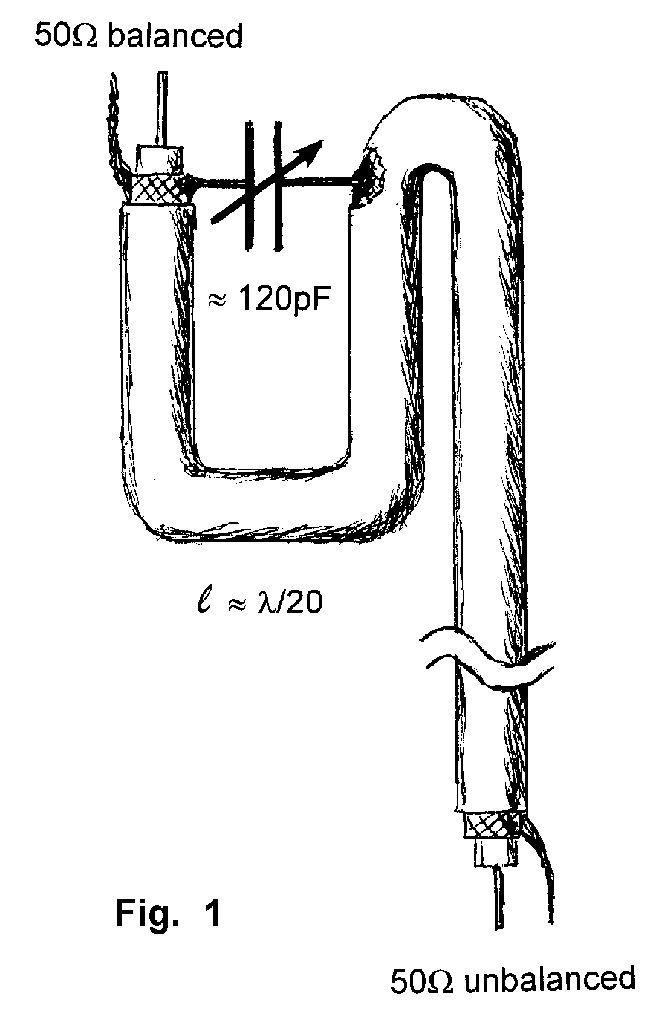
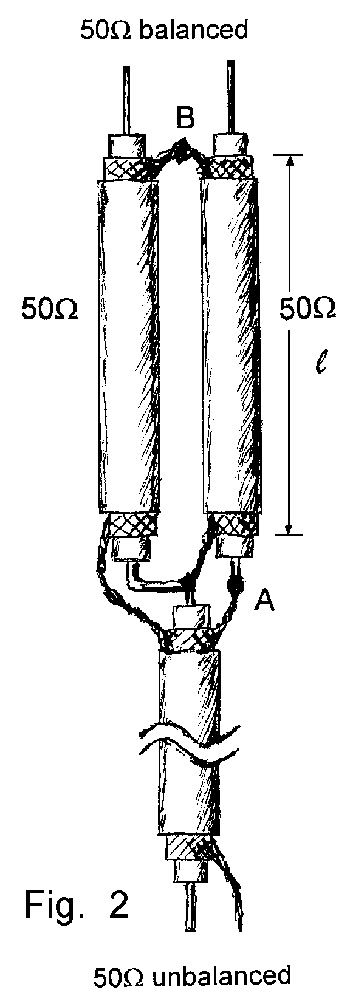 If you are dealing with radiofrequency
aerials you might like to experiment with the configurations proposed.
In fig. 1 there is a balun which transforms an unbalanced line into a
balanced feed. You need to connect a variable capacitor, typically a
trimmer capacitor, between two points on the braid of the terminal part
of the coaxial cable as shown in the drawing. The length and the
capacitor value are optimized for operation in the Citizen Band and 50Ω cable but the set up is not critical
at all and should work at other frequencies as well. The advantage of
this balun is that you can provide a perfectly balanced feed to the
aerial thus compensating for any unbalance introduced by the topography
of the ground around the same aerial. Another interesting application
for this balun is to use it as a power splitter: if you measure the
output power relative to ground (i.e. the cold side of the capacitor),
you may adjust the power fed to the two terminals by simply operating on
the capacitor. The phase relationship has not been investigated. Fig. 2
is a more classical approach to the problem: two quarter wavelength
sections of the same coaxial cable give a balanced output with the least
of trouble, but it must be mentioned that it works well only around the
designed frequency, it is not a wideband balun. Length l is equal to (λ/4)xP
where λ
is the operating wavelength and P is the propagation
factor which depends on the type of dielectric material used in the
coaxial cable as shown in the table:
If you are dealing with radiofrequency
aerials you might like to experiment with the configurations proposed.
In fig. 1 there is a balun which transforms an unbalanced line into a
balanced feed. You need to connect a variable capacitor, typically a
trimmer capacitor, between two points on the braid of the terminal part
of the coaxial cable as shown in the drawing. The length and the
capacitor value are optimized for operation in the Citizen Band and 50Ω cable but the set up is not critical
at all and should work at other frequencies as well. The advantage of
this balun is that you can provide a perfectly balanced feed to the
aerial thus compensating for any unbalance introduced by the topography
of the ground around the same aerial. Another interesting application
for this balun is to use it as a power splitter: if you measure the
output power relative to ground (i.e. the cold side of the capacitor),
you may adjust the power fed to the two terminals by simply operating on
the capacitor. The phase relationship has not been investigated. Fig. 2
is a more classical approach to the problem: two quarter wavelength
sections of the same coaxial cable give a balanced output with the least
of trouble, but it must be mentioned that it works well only around the
designed frequency, it is not a wideband balun. Length l is equal to (λ/4)xP
where λ
is the operating wavelength and P is the propagation
factor which depends on the type of dielectric material used in the
coaxial cable as shown in the table:
|
Dielectric |
P |
Typical Cable |
|
Solid polyethylene |
0.665 |
RG 58 / RG 11 |
|
Polyethylene/air |
0.835 |
RG 62 / RG 79 |
|
Fluorocarbon (Teflon) |
0.675 |
RG 94 / RG 209 |
|
Foam polyethylene |
0.816 |
TV cable |

 The balun in fig. 2 can
be wired also as in fig. 3. In fact, points A and B are at the same
potential and can be connected together. Nothing changes from the
electrical point of view but it can make a more compact construction in
certain circumstances. The first application will allow you to install a
CB car aerial in any other place without the need of the metal body of
the car (fig. 4). The vertical section of the coaxial cable is
short-circuited at the lower end. You might need to adjust the length of
the whip, once in its final place, because distance d is to be
subtracted from the total length of the car aerial.
The balun in fig. 2 can
be wired also as in fig. 3. In fact, points A and B are at the same
potential and can be connected together. Nothing changes from the
electrical point of view but it can make a more compact construction in
certain circumstances. The first application will allow you to install a
CB car aerial in any other place without the need of the metal body of
the car (fig. 4). The vertical section of the coaxial cable is
short-circuited at the lower end. You might need to adjust the length of
the whip, once in its final place, because distance d is to be
subtracted from the total length of the car aerial.
The typical application is shown in fig. 5. Two different lengths are given: one applies to 50Ω cables and baluns and the other applies to 75Ω cables and baluns (fig. 7), these values are good for the design of receiving FM or TV aerials right up to UHF. It must be said that these designs are narrow band aerials and are not suitable to cover a wide frequency range. This means that if you tune to a specific TV channel you will get a performance that could be better than a Yagi but gives poor results at other channels. One way around is to purposefully mismatch the design in order to cover a wider range but I was unable to assess how good this solution was.
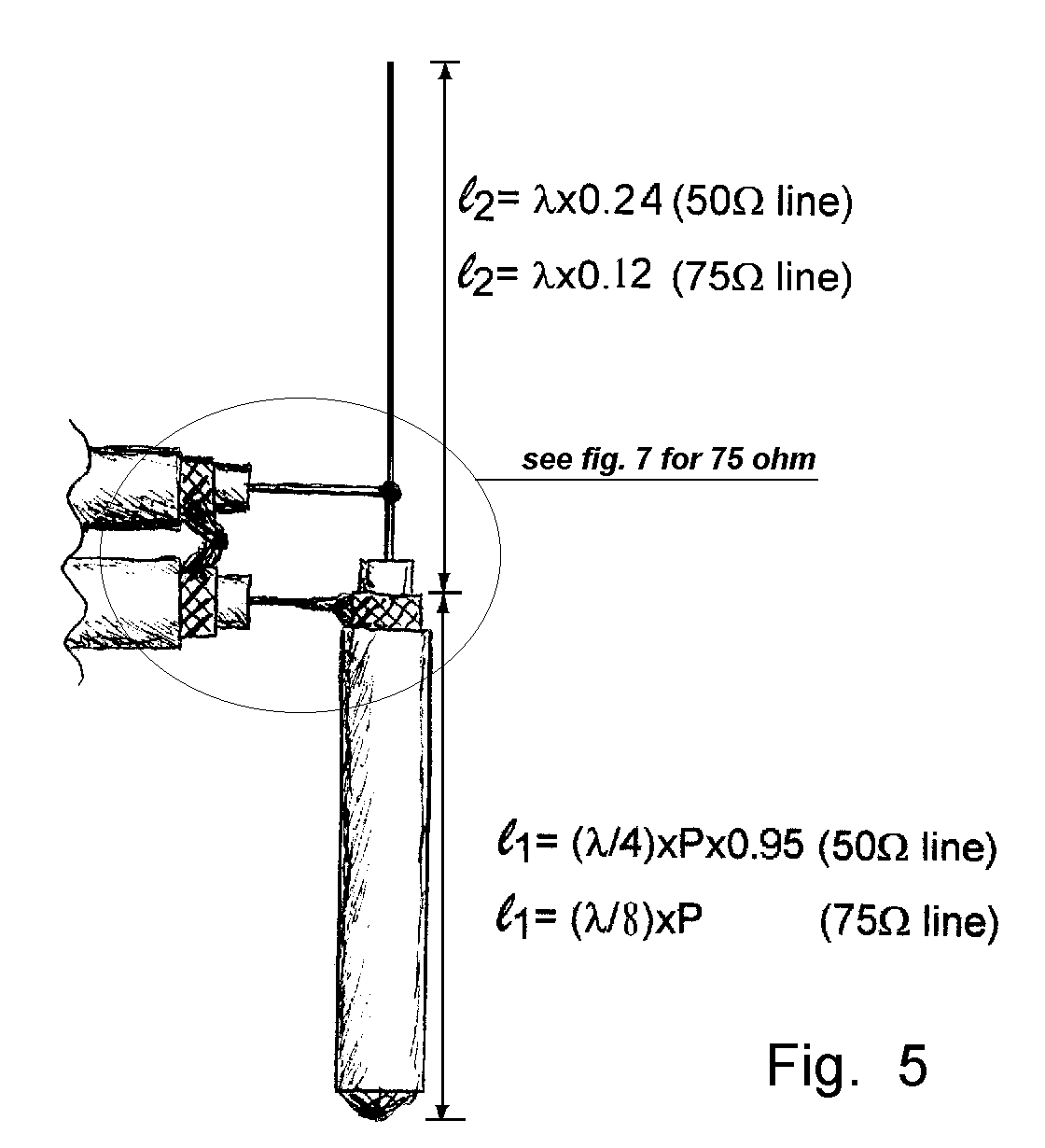
 If you find that the aerial is too long at
the working frequency, you could apply the design of fig. 6 where a coil
is inserted at the base of the aerial. The coil is made with 17 turns of
2mm electric wire on a 17mm form. These data are valid for the 27Mhz
band and must be properly scaled at other frequencies. In all cases the
vertical coax must be shorted at the far end because it works also as an
impedance matcher for the rest of the aerial. Installation can be
vertical, as shown in the drawings, or horizontal.
If you find that the aerial is too long at
the working frequency, you could apply the design of fig. 6 where a coil
is inserted at the base of the aerial. The coil is made with 17 turns of
2mm electric wire on a 17mm form. These data are valid for the 27Mhz
band and must be properly scaled at other frequencies. In all cases the
vertical coax must be shorted at the far end because it works also as an
impedance matcher for the rest of the aerial. Installation can be
vertical, as shown in the drawings, or horizontal.

All the mentioned aerials were tested in the 27Mhz band with satisfactory results: best performance being from the design of fig. 5. Gain was measured between 6 and 9 dB but the instrument available was not very accurate and I cannot bet on the number reported. As a receiving aerial it was tested in the FM range, VHF and UHF: in the VHF range I could see a TV channel that I was unable to see with a 4 element Yagi; in the UHF range the mechanical construction is rather critical due to the small size and the need of a wideband aerial becomes a major drawback.
SINGLE LED FLASHER
 Flashing a LED should
not require a complex circuit. A reverse biased transistor does the job
in a nice way. Circuit "a" flashes the LED twice a second:
changing the capacitor and/or the resistor will change the frequency,
also the supply voltage will influence its frequency of operation. A
BC337 can be used instead of the 2N2222A; in this case the supply
voltage can be lowered to 9V. Circuit "b" gives the same result
but it will work directly off the mains, so be careful with the live
wire because it can be a hazard if you do not take all necessary
precautions. If the mains voltage is 110VAC the resistor should be
decreased from 100K to 47K. If a BC337 is used, then the resistor is
390K for a 220V mains and 180K for a 110V mains. The zener is not
required for its operation: it is only a safety measure that avoids
voltage build up if the LED gets disconnected. When you reconnect it,
the current surge will destroy the transistor and the LED. The capacitor
could be damaged as well. Both circuits will work with all coloured led
but circuit "a"
will require a 2V higher supply
voltage if you use white or blue led.
Flashing a LED should
not require a complex circuit. A reverse biased transistor does the job
in a nice way. Circuit "a" flashes the LED twice a second:
changing the capacitor and/or the resistor will change the frequency,
also the supply voltage will influence its frequency of operation. A
BC337 can be used instead of the 2N2222A; in this case the supply
voltage can be lowered to 9V. Circuit "b" gives the same result
but it will work directly off the mains, so be careful with the live
wire because it can be a hazard if you do not take all necessary
precautions. If the mains voltage is 110VAC the resistor should be
decreased from 100K to 47K. If a BC337 is used, then the resistor is
390K for a 220V mains and 180K for a 110V mains. The zener is not
required for its operation: it is only a safety measure that avoids
voltage build up if the LED gets disconnected. When you reconnect it,
the current surge will destroy the transistor and the LED. The capacitor
could be damaged as well. Both circuits will work with all coloured led
but circuit "a"
will require a 2V higher supply
voltage if you use white or blue led.
LONG DELAY TIMER
 A max.
delay of 20 hours is achieved by this relatively simple circuit. A
permanent ground, or no signal, at the trigger input starts the timer. A
ground at the relay output is available after a set time that depends on
the connection of the transistor base (X) to one of the counter output:
connection with (C) gives a min. delay of 1m 40s and max. of 18m 30s.
Connection with (B) gives a min. delay of 13m 20s and max. of 2h 28m.
Connection with (A) gives a min. delay of 1h 47m and max. of 20h. Supply
voltage is between 6 and 15V and longer delay could be obtained by
increasing the capacitor value up to 10 times with a delay in excess of
1 week. A positive at the trigger input will reset the counter. Adjust
the 100K pot. for the desired timing. The load is typically a relay but
any load with a max. current of 200 mA will work fine. Admittedly this
is not a very original circuit but can save some time if you need to
build one. The IC is a Cmos 24-stage binary counter MC4521B from
Fairchild, or alternatively, you may use the MC14521B from Motorola.
A max.
delay of 20 hours is achieved by this relatively simple circuit. A
permanent ground, or no signal, at the trigger input starts the timer. A
ground at the relay output is available after a set time that depends on
the connection of the transistor base (X) to one of the counter output:
connection with (C) gives a min. delay of 1m 40s and max. of 18m 30s.
Connection with (B) gives a min. delay of 13m 20s and max. of 2h 28m.
Connection with (A) gives a min. delay of 1h 47m and max. of 20h. Supply
voltage is between 6 and 15V and longer delay could be obtained by
increasing the capacitor value up to 10 times with a delay in excess of
1 week. A positive at the trigger input will reset the counter. Adjust
the 100K pot. for the desired timing. The load is typically a relay but
any load with a max. current of 200 mA will work fine. Admittedly this
is not a very original circuit but can save some time if you need to
build one. The IC is a Cmos 24-stage binary counter MC4521B from
Fairchild, or alternatively, you may use the MC14521B from Motorola.
MAINS FREQUENCY METER
 Mains
frequency is pretty stable and it is unlikely that you have to measure
it but if you have an emergency generator you might find this circuit
useful as it will give an indication whether the generator is running
too fast or too slow. Actually you can use the mains frequency to
calibrate it by adjusting the 25K multiturn trimmer until it reads 0.
The odd looking components values are easily obtained using standard
values: 3777 is 3900 in parallel with 120KΩ,
4020 is 3900 and 120 in series, 570nF is 470nF with 100nF in parallel
and 400nF is 4 x 100nF capacitors in parallel. Components should be
chosen for their stability and precision. 1% tolerance would be ideal
but 5% is acceptable so long as you measure them with a good meter.
Capacitors should be properly rated for direct connection to the mains
and resistors should have a low temperature coefficient as it will
adversely affect the zero setting and change the filters response. The
100μF capacitor could be
occasionally reverse biased with a voltage of 0.1-0.2 V. There is no
problem for the capacitor which is generously rated. Operation is quite
simple: connect it first to the mains, wait about 4-5 minutes until all
resistors reach their working temperature, calibrate, and then connect
to the generator. Variation in the mains voltage will not change the
zero setting but will make the meter more or less sensitive: for
example, a reading of 51 Hz will show as 51.1 with a 10% supply voltage
increase.
Mains
frequency is pretty stable and it is unlikely that you have to measure
it but if you have an emergency generator you might find this circuit
useful as it will give an indication whether the generator is running
too fast or too slow. Actually you can use the mains frequency to
calibrate it by adjusting the 25K multiturn trimmer until it reads 0.
The odd looking components values are easily obtained using standard
values: 3777 is 3900 in parallel with 120KΩ,
4020 is 3900 and 120 in series, 570nF is 470nF with 100nF in parallel
and 400nF is 4 x 100nF capacitors in parallel. Components should be
chosen for their stability and precision. 1% tolerance would be ideal
but 5% is acceptable so long as you measure them with a good meter.
Capacitors should be properly rated for direct connection to the mains
and resistors should have a low temperature coefficient as it will
adversely affect the zero setting and change the filters response. The
100μF capacitor could be
occasionally reverse biased with a voltage of 0.1-0.2 V. There is no
problem for the capacitor which is generously rated. Operation is quite
simple: connect it first to the mains, wait about 4-5 minutes until all
resistors reach their working temperature, calibrate, and then connect
to the generator. Variation in the mains voltage will not change the
zero setting but will make the meter more or less sensitive: for
example, a reading of 51 Hz will show as 51.1 with a 10% supply voltage
increase.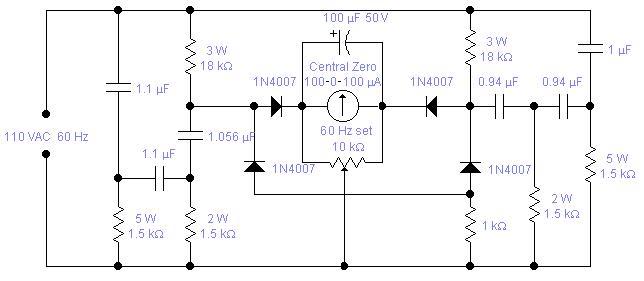 Full scale deflection is around +/- 2 Hz. If
you wish to accommodate a wider range of +/- 3.5 Hz, typical for a
petrol driven generator, you have to change the 2.2KΩ
resistor to 12KΩ.
Full scale deflection is around +/- 2 Hz. If
you wish to accommodate a wider range of +/- 3.5 Hz, typical for a
petrol driven generator, you have to change the 2.2KΩ
resistor to 12KΩ.
WARNING! This circuit is directly connected to the mains and should be assembled in a box which will avoid access to any of its part and care must be exercised when calibrating the unit. If you live in the States or you have a 110 VAC, 60 Hz mains, you may try the second circuit: the reported values are calculated values, I did not actually test the unit. The odd capacitors values are easily obtained with the combination of standard values: 0.94 is 2 x 0.47 in parallel, 1.056 is 1μF + 56nF in parallel and 1.1 is 1 + 0.1μF.
ELECTRONIC RELAY
 In some
applications where you require speed of operation and no contact
bouncing, you may find this circuit helpful. This is really the
implementation of an SCR with discrete components. The medium power
complementary pair will switch on and off a load up to 3A. You may
modify the circuit to carry up to 10A using suitable power transistors
and diodes. The left side of the circuit shows a typical drive. This
electronic relay will latch in the on or off position depending on the
direction of the pulse going through the primary winding of the
transformer. You may omit the capacitor altogether; in this case the
circuit behaves very much like the coil of a relay: when you apply a
voltage to the primary it will switch on and when you remove the voltage
it will switch off. The drawback in this second case is that there is a
large amount of power dissipated in the 12Ω
resistor which must be rated accordingly. The pulse transformer is
recovered from a faulty electronic neon light. The drive circuit for
these lamps always includes a pulse transformer. The higher impedance,
or resistance, is the primary and the other winding is the secondary.
The measured resistance was below 0.4Ω and the
inductance was 680 and 47μH for the
primary and secondary respectively. The ideal would be a pulse
transformer with two secondary windings so that both transistors could
be driven but you have the same results if the drive is applied to one
transistor only. The circuit has its limitations: there is a voltage
drop across the switch, in the on state, between 0.7 and 1V, this may
not be acceptable in low voltage applications; it will work only with DC
supplies and there is a minimum sustain current, 12mA in the circuit
shown. Below this current the switch will revert to its off state. You
may, of course, design a circuit with low power transistors with a
sustain current of only a few μA if
necessary.
In some
applications where you require speed of operation and no contact
bouncing, you may find this circuit helpful. This is really the
implementation of an SCR with discrete components. The medium power
complementary pair will switch on and off a load up to 3A. You may
modify the circuit to carry up to 10A using suitable power transistors
and diodes. The left side of the circuit shows a typical drive. This
electronic relay will latch in the on or off position depending on the
direction of the pulse going through the primary winding of the
transformer. You may omit the capacitor altogether; in this case the
circuit behaves very much like the coil of a relay: when you apply a
voltage to the primary it will switch on and when you remove the voltage
it will switch off. The drawback in this second case is that there is a
large amount of power dissipated in the 12Ω
resistor which must be rated accordingly. The pulse transformer is
recovered from a faulty electronic neon light. The drive circuit for
these lamps always includes a pulse transformer. The higher impedance,
or resistance, is the primary and the other winding is the secondary.
The measured resistance was below 0.4Ω and the
inductance was 680 and 47μH for the
primary and secondary respectively. The ideal would be a pulse
transformer with two secondary windings so that both transistors could
be driven but you have the same results if the drive is applied to one
transistor only. The circuit has its limitations: there is a voltage
drop across the switch, in the on state, between 0.7 and 1V, this may
not be acceptable in low voltage applications; it will work only with DC
supplies and there is a minimum sustain current, 12mA in the circuit
shown. Below this current the switch will revert to its off state. You
may, of course, design a circuit with low power transistors with a
sustain current of only a few μA if
necessary.
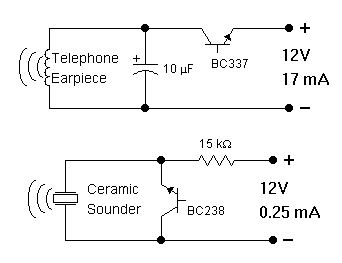 In order to
generate a single note you may try these simple circuits. With only
three components you may implement some basic buzzers. You need a
telephone earpiece for the first circuit. Any old telephone set has got
one of those magnetic earpiece that is right for our purposes. Add an
extra capacitor and a transistor and you have your buzzer. Frequency of
operation is about 1800 Hz and the capacitor must be changed if you wish
to have a different frequency. The second circuit is implemented with a
ceramic sounder: its intrinsic capacity is used to make another simple
buzzer. Working frequency is 800 Hz and power drain is really low. The
operating voltage is 9.5 - 20V for the circuit with the ceramic sounder
and 8 - 16V for the other circuit. Do not expect a loud sound level: it
is rather limited just as the current drain is. These buzzers are
suitable for audio signaling on portable devices and wherever it is
necessary to have a sound source implemented with a minimum components
count. Not all transistors will oscillate: you have to use the specified
type although I found that the BC109 and 2N2222A will also work albeit
at a slightly different voltage.
In order to
generate a single note you may try these simple circuits. With only
three components you may implement some basic buzzers. You need a
telephone earpiece for the first circuit. Any old telephone set has got
one of those magnetic earpiece that is right for our purposes. Add an
extra capacitor and a transistor and you have your buzzer. Frequency of
operation is about 1800 Hz and the capacitor must be changed if you wish
to have a different frequency. The second circuit is implemented with a
ceramic sounder: its intrinsic capacity is used to make another simple
buzzer. Working frequency is 800 Hz and power drain is really low. The
operating voltage is 9.5 - 20V for the circuit with the ceramic sounder
and 8 - 16V for the other circuit. Do not expect a loud sound level: it
is rather limited just as the current drain is. These buzzers are
suitable for audio signaling on portable devices and wherever it is
necessary to have a sound source implemented with a minimum components
count. Not all transistors will oscillate: you have to use the specified
type although I found that the BC109 and 2N2222A will also work albeit
at a slightly different voltage.
![]() Eager for more
Eager for more  Full astern to main page
Full astern to main page
![]()